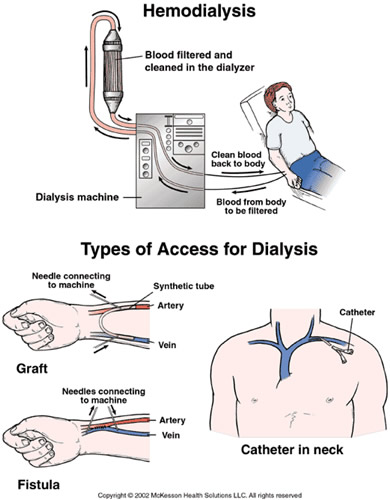The kidneys remove waste from the blood. When they fail, they can no longer do this important job. Hemodialysis does this job for you, keeping the blood clean. Before dialysis can be done, an access is needed, which is usually placed in the arm.
Types of Accesses:
- Fistula – connecting an artery to a nearby vein. A fistula may take weeks to months before it is mature enough to use.
- Graft (a piece of manmade tube) – sewn between an artery and a vein if a fistula is not available. A graft is usually ready to use in a few weeks.
- Tunneled dialysis catheter – this may be used if neither a fistula nor a graft works for the patient or on a temporary basis.
Hemodialysis takes 3 to 5 hours and is usually done 3 times a week. Two needles are inserted into your access. The blood then flows through 1 needle and a connecting tube to the dialyzer. The blood is cleansed and then returned to your body.
Care of Your Access: An infection may make the access unusable, in which case, you may need a new access. Follow these guidelines to help your access last:
- Do not wear tight clothes or jewelry around your access.
- Do not let anyone take your blood pressure on or draw blood from the arm with the access.
- Protect your access from being hit or cut.
- Wash your hands often and keep the access area clean.
If you have any of the following problems, contact your physician immediately:
- You cannot feel your thrill. To do this, place your fingers over your access. You should be able to feel the blood rushing through it. This is a thrill. Feel for this as often as you are instructed.
- You have pain or numbness in your hand or arm.
- You have bleeding, redness, or warmth around the access.
- You notice your access suddenly bulging out more than usual – a slight bulge is normal.
- You have a fever over 101°.


